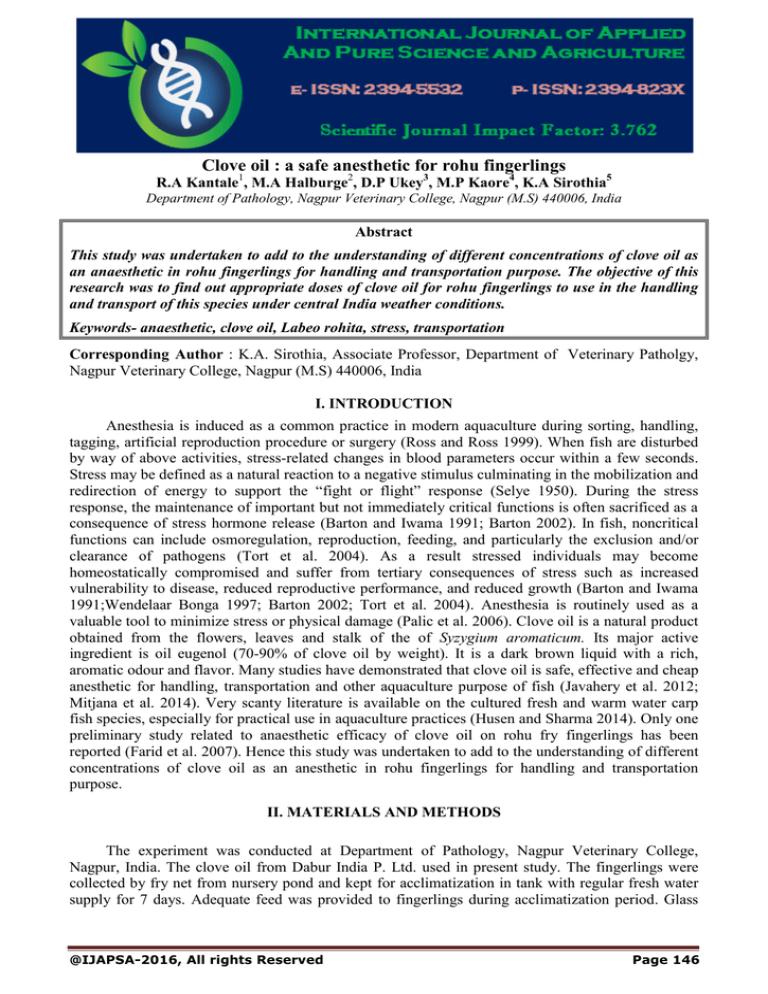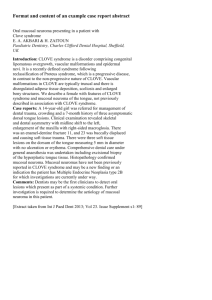
Clove oil : a safe anesthetic for rohu fingerlings
R.A Kantale1, M.A Halburge2, D.P Ukey3, M.P Kaore4, K.A Sirothia5
Department of Pathology, Nagpur Veterinary College, Nagpur (M.S) 440006, India
Abstract
This study was undertaken to add to the understanding of different concentrations of clove oil as
an anaesthetic in rohu fingerlings for handling and transportation purpose. The objective of this
research was to find out appropriate doses of clove oil for rohu fingerlings to use in the handling
and transport of this species under central India weather conditions.
Keywords- anaesthetic, clove oil, Labeo rohita, stress, transportation
Corresponding Author : K.A. Sirothia, Associate Professor, Department of Veterinary Patholgy,
Nagpur Veterinary College, Nagpur (M.S) 440006, India
I. INTRODUCTION
Anesthesia is induced as a common practice in modern aquaculture during sorting, handling,
tagging, artificial reproduction procedure or surgery (Ross and Ross 1999). When fish are disturbed
by way of above activities, stress-related changes in blood parameters occur within a few seconds.
Stress may be defined as a natural reaction to a negative stimulus culminating in the mobilization and
redirection of energy to support the “fight or flight” response (Selye 1950). During the stress
response, the maintenance of important but not immediately critical functions is often sacrificed as a
consequence of stress hormone release (Barton and Iwama 1991; Barton 2002). In fish, noncritical
functions can include osmoregulation, reproduction, feeding, and particularly the exclusion and/or
clearance of pathogens (Tort et al. 2004). As a result stressed individuals may become
homeostatically compromised and suffer from tertiary consequences of stress such as increased
vulnerability to disease, reduced reproductive performance, and reduced growth (Barton and Iwama
1991;Wendelaar Bonga 1997; Barton 2002; Tort et al. 2004). Anesthesia is routinely used as a
valuable tool to minimize stress or physical damage (Palic et al. 2006). Clove oil is a natural product
obtained from the flowers, leaves and stalk of the of Syzygium aromaticum. Its major active
ingredient is oil eugenol (70-90% of clove oil by weight). It is a dark brown liquid with a rich,
aromatic odour and flavor. Many studies have demonstrated that clove oil is safe, effective and cheap
anesthetic for handling, transportation and other aquaculture purpose of fish (Javahery et al. 2012;
Mitjana et al. 2014). Very scanty literature is available on the cultured fresh and warm water carp
fish species, especially for practical use in aquaculture practices (Husen and Sharma 2014). Only one
preliminary study related to anaesthetic efficacy of clove oil on rohu fry fingerlings has been
reported (Farid et al. 2007). Hence this study was undertaken to add to the understanding of different
concentrations of clove oil as an anesthetic in rohu fingerlings for handling and transportation
purpose.
II. MATERIALS AND METHODS
The experiment was conducted at Department of Pathology, Nagpur Veterinary College,
Nagpur, India. The clove oil from Dabur India P. Ltd. used in present study. The fingerlings were
collected by fry net from nursery pond and kept for acclimatization in tank with regular fresh water
supply for 7 days. Adequate feed was provided to fingerlings during acclimatization period. Glass
@IJAPSA-2016, All rights Reserved
Page 146
International Journal of Applied and Pure Science and Agriculture (IJAPSA)
Volume 02, Issue 05, [May- 2016]e-ISSN: 2394-5532, p-ISSN: 2394-823X
aquaria of (1×1×1) ft >45L equipped with aeration stone was used in the entire experiment. The pH
of water was maintained at 7-7.2 throught out the experiment. The temperature of water and
environmental was 28-300C and 37-390C respectively.
The clove oil was evaluated at concentration of 15,20,25,33 and 50 µl/L-1. The fingerlings
were starved for 24 h prior to the experiment and divided into two group each containing 6
fingerlings and transferred to experimental tank (45L) containing anaesthetic solution (10L). Only
one concentration of clove oil was tested at a time. A control group was kept for every tested
concentration of clove oil. For each concentration stages of anesthesia and recovery behavior were
observed and recorded continuously for 12 h. After 12 h fingerlings were transferred to recovery
tanks and monitored for another 24 h time for any mortality. Time of recovery was recorded in
seconds using electronic stopwatch.
III. RESULTS AND DISCUSSION
The time (min) of anaesthesia stages and recovery in rohu fingerlings are presented in table 1
&2. No mortality in rohu fingerlings was observed during the experimental period.
Table no.1
Sr.
No.
1
2
Description of behavioural signs
Stages
3
Loss of gross body movements but with continued opercular
movements and light narcosis
Stage 2
4
5
Deep narcosis with very indiscernible opercular movements
Surgical anaesthesia
Stage 3
Stage 4
Normal
Loss of equilibrium
Stage 1
Table no. 2
Concentratio
n
(µl/ L-1)
Stages of anesthesia (minutes)
A
Normal
10
1
2
3
4
-
-
-
-
Recovery
(min)
Surviva
l rate
(24 hrs)
(%)
15
..
6
..
..
..
..
100
20
..
4-5
5-6
6-9
9-10
3-4
100
25
..
4
4-6
6-7
7-9
4-5
100
33
..
3.58
5.50
6-7
7-8
4-5
100
50
..
2.52
3.52
6.51
7.51
>6
100
The clove oil was evaluated at concentration of 15,20,25,33 and 50 µl/L-1. Except at
concentration of 15 µl/L-1 at all the concentrations surgical anaesthesia stage was observed within 10
min which indicates that the concentration of clove oil was sufficient. The clove oil concentrations
between 33-50 µl/L-1 are sufficient to produce anaesthesia in a majority of fish species (Alam et al.
@IJAPSA-2016, All rights Reserved
Page 147
International Journal of Applied and Pure Science and Agriculture (IJAPSA)
Volume 02, Issue 05, [May- 2016]e-ISSN: 2394-5532, p-ISSN: 2394-823X
2012; Hamackova et al. 2006). At given concentration of clove oil ideal anaesthetic crieteria of rapid
induction (<_3 min) and recovery (<_ 5 min) could not observed. This observation was incontrarary
to observation of Husen and Sharma (2015) they observed surgical anesthesia as per criteria of ideal
anaesthetics at 50 µl/L-1 in rohu fingerlings. This difference could be due to temperature, body size
and density of fish in the bath as these parameters influence the efficacy of most anesthetics. After
recovery rohu fingerlings were observed upto 24 hrs and no mortality was recorded at any
concentration of clove oil. The observations of present study will be useful in for handling
procedures (e.g. measurements blood samples etc.) under Indian condition. At 10 and 15 µl/L-1
surgical anaesthesia stage was not observed and fingerlings kept in anaesthetic solution for 24. At 10
µl/L-1 light sedation i.e. reduced swimming activity slight loss of reactivity to tactile stimuli but
without loss of equilibrium. At 15 µl/L-1 reduced swimming activity with complete loss of
equilibrium was observed. When fingerlings were removed from anaesthetic bath after 24 h they
regain all activity without any adverse effects. Ten microlitre per litre concentration can be safely
used for transportation to mitigate stress of transport and reduce mortality.
IV. Conclusion
This research work will add new affirmation to anesthesia technique in rohu fish and will be
applicable to the Indian Subcontinent which is home to rohu. Hence fish farmers can easily adopt this
technology.
V. Acknowledgement
The authors are thankful to Head of Department of Pathology and Associate Dean of college
for providing all facilities for this study.
BIBLIOGRAPHY
1.
2.
3.
4.
5.
6.
7.
8.
9.
10.
11.
12.
13.
14.
15.
Alam, M.M., Ahsan, M.K., Parween, S., (2012) Efficacy of clove oil as a fish anaesthetic against four freshwater
hardy fishes. DAV Int J. Science 1: 158-161.
Barton, B. A. (2002) Stress in fishes: a diversity of responses with particular reference to changes in circulating
corticosteroids. Integrative and Comparative Biology 42:517–525.
Barton, B.A. and Iwama, G.K. (1991) Physiological changes in fish from stress in aquaculture with emphasis on the
response and effects of corticosteroids. Annu Rev Fish Dis 1:3–26.
Farid, S.M., Rahman, M.M., Shirin, K.K., Nur, N.N. (2008) Effect of clove oil as an anesthetic on Labeo rohita
(Hamilton) J.Agr forest Env 2:1-6.
Hamackova, J., Kouril, J., Kozak, I.P., Stupka, Z., (2006) Clove oil as an anaesthetic for differerent freshwater fish
species. Bul J Agr Sci 12: 185-194.
Husen, M.A. and Sharma, S. (2014) Efficacy of anesthetics for reducing stress in fish during aquaculture practices- a
review. KUSET 10:104-123.
Husen, M.A. and Sharma, S. (2015) Immersion of rohu fingerlings in clove oil reduced handling and confinement
stress and mortality. Int. J. of Fiseries and aquatic studies 2: 299-305.
Javahery, S., Nekoubin, H., Moradlu, A. H. (2012) Effect of anaesthesia with clove oil in fish. Fish Physiol
Biochem 38:1545-1552.
Mitjana, O., Bonastre,C., Insua D, Falceto MV, Esteban J, Josa A et al. (2014) The efficacy and effect of repeated
exposure to 2-phenoxyethanol, clove oil and tricaine methanesulphonate as anesthetic agents on juvenile Angelfish
(Pterophyllum scalare). Aquaculture 433: 491-495.
Palic, D. Herolt, D. Andreasen, C. Menzel, B. (2006) Anesthetic efficacy of tricane methanesulfonate, metomitade
and eugenol.Effect of plasma cortisol concentration and neutrophils function in fathead minnows (Pimephales
promelas) Aquaculture 254: 675-685.
Ross, G.L. and Ross, B.R. (1999) Stress in aquatic animals. In: Ross GL (ed) Anaesthetic and sedative techniques for
aquatic animals, vol 77. Blackwell Science, Ltd, Bodmin, pp 5–21.
Ross, L.G. and Ross, B. (2008) Anaesthetic and Sedative Techniques for Aquatic Animals. Blackwell Publishing,
Oxford, U.K, 222.
Selye, H. (1950) Stress and the general adaptation syndrome. British Medical Journal 1950:1383–1392.
Tort, L. Balasch, J. C. and MacKenzie, S. (2004) Fish health challenge after stress. Indicators of
immunocompetence. Contributions to Science 2: 443–454.
Wendelaar Bonga, S. E. (1997) The stress response in fish. Physiology. Reviews 77: 591–625.
@IJAPSA-2016, All rights Reserved
Page 148


